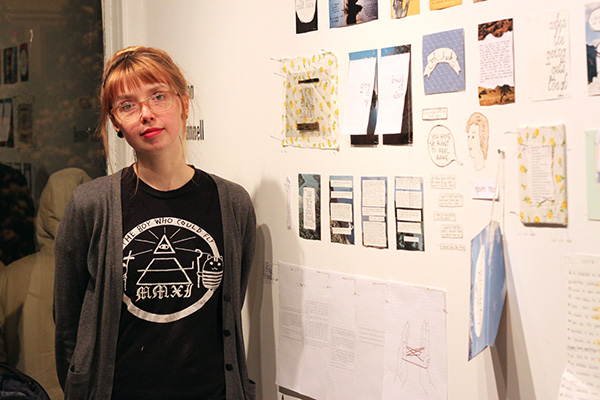
Twelve framed tally sheets of assorted sizes and colors hang on one wall, and various paper scraps filled with colorful, Daniel Clowes-esque drawings and loopy script are pinned to another.
Nearly 40 people milled in and out of Team Love RavenHouse Gallery for the snowy opening of their newest exhibition, “9 and 13: A Works on Paper Show,” on Monday, March 18. The show, which runs through May, features work from zine author Kate Larson and coloring book artist Jacinta Bunnell.
Team Love RavenHouse Gallery’s Director Cornelia Calder said the show was very “spontaneous,” and that she only started planning it three weeks ago, after receiving an e-mail from Helen Money, an electric cellist who was traveling through the area.
“We checked her out and instantly liked her work,” Calder said. “It seemed like a great opportunity and that was the only night she had free. I was a little concerned about pulling something together. We’re not interested in making money off these events. We’re interested in connecting people, so they can actually talk and listen to live music.”
As soon as Calder decided to put the show together, she said she contacted Larson “within the same hour,” because she had always wanted to work with her and knew Larson was organizing a reading at Inquiring Minds that Bunnell was reading at.
“I thought her work and [Money’s] music would work really well together — they’re dark and light,” Calder said. “They both go from one really intense emotion to the next.”
Larson’s two “wall clusters” feature work from issue nine of her zine, No Better Than Apples, and a smaller group of drawings and pieces from past zines. She said the exhibition also contains “master pages,” which are the “collaged-together pages” she photocopies to make the zines.
“I said yes to the show under the premise that I wouldn’t have to make anything new,” Larson said. “I didn’t have time to, and I didn’t know how I felt about making pieces intentionally for an art show. I really just gathered what I already had. When the zines go out into the world, the original pages are typically left in piles in my room, gettin’ dusty. These fragments already existed, it’s just that no one really ever got to see them.”
Larson said Calder approached her after reading the most recent issue of No Better Than Apples, because she was interested in highlighting it. She said it’s the most “personally relevant” issue that exists thus far, because it deals with her diagnosis with multiple sclerosis.
“It is a little more intense than other issues have been,” Larson said. “For that same reason, I think it’s been resonating with people more. With zines, sometimes the more personal the subject matter is, the more people can relate it back to their own lives and get more out of it.”
Despite feeling “strange and vulnerable” about displaying her very “personal” work in such a public sphere for the first time, Larson said she’s trying to “diffuse” the conflict she feels toward galleries.
“Zine making is a very private process for me, and reading zines is a private act for most people,” she said. “[I’m] reminding everyone that I don’t really consider myself an ‘artist,’ and zines are a casual medium. Everyone can make a zine. Everyone should make a zine.”
Bunnell’s current project “13” — an ongoing collaboration with her stepfather — features tally sheets from a card game her family acquired in the 1970s from her grandparents’ Florida retirement community.
“I add color and pattern to his superbly beautiful grid work tally sheets,” she said. “I have been playing ‘Thirteen’ since I was 7 years old, but just started working on [them] as art a few years ago.”
Bunnell said her favorite material is “found” paper, because it already has “patterns, words and themes” built into it.
“I love to use materials that would otherwise be discarded or taken for granted…and give them new life,” she said. “I take direction from the paper.”
As far as similarities between the artists, Calder said she sees both of them as very “connected” to their work processes and preferred medium — paper.
“They both really love paper,” she said. “They collect and have an attachment to paper itself. They are both very driven by line and the hand — the evidence of the hand is readily evident in their bodies of work. They’re aware of the way things are made.”





